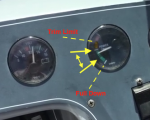Mid-season Update:
I have been using the electro-mechanical indicators for a month or so now and have found the trim range where the outdrives like to be, based on various sea and loading conditions. Essentially, it is the middle 1/3 of the trim range, as pictured below and indicated by the arrows:

The full trim limit is actually 3/4 of the gauge movement as shown by the 2 green ranges and the yellow range on the gauge. (that's just how the electrical part of the system worked out, and I am still trying to decide if I like it that way . . . ) The tilt range is the red area.
So, for travelling into the chop, I tend to trim down just a pinch from the dial reading shown to stick the bow into the waves. When running with the chop, I tried trimming up a bit from where the dial is (so top of the green range), but the props wanted to ventilate a bit on the down side of the wave, since the boat was slightly nose down at that point. So, I usually have to bring the outdrives down a pinch to the middle of the second green, as shown in the picture.
In flat sea conditions, if I trim up closer to the trim limit (yellow range on the dial) the boat slows down a couple of mph. And if I trim way down it puts the bow down too much. Top of the green range is about right for flat sea conditions.
Overall . . . So, far so, good, because I can get he trim dialed in really quickly and it is very consistent. The interesting thing is that the trim cylinder movement for these adjustments is only +/- 0.5" (half an inch) . The standard trim senders would barely pick up that small amount of movement, since they have a few degrees of play in them, which equates to about 0.5" of trim cylinder movement. This system seems to be sensitive to the slightest movement of the trim cylinders, which is great.

I think I am liking the way the system is set up now with the tilt range being 3/4 of the gauge movement (2 greens + the yellow range), as it is more sensitive to small adjustments of the outdrive. The tilt range being only 1/4 of the gauge movement is not all that important.





















